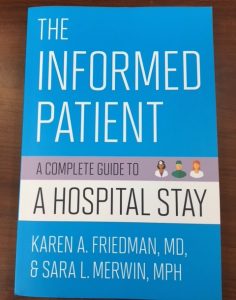What You Need to Protect Yourself During a Hospital Stay

I am delighted to have acted as the editor at the Cornell University Press Culture and Politics of Healthcare Work Series on this wonderful new book The Informed Patient: A Complete Guide to a Hospital Stay by Sara L. Merwin and Karen Friedman. I have asked Sara to do a short blog post that will give you a hint of how useful this book is. This is really a must have book for almost all of us since most of us will be in the hospital some day and need to know all the invaluable things the book conveys. So here is a sample, and I hope you consider purchasing a copy — particularly if you are a frequent user of hospital care. The book helps you navigate an alien system and learn everything from how to make sure doctors and nurses give you adequate pain medication before they change the dressing on your wound, to who to ask about what (don’t ask doctors about nursing issues because they don’t know what nurses do) to safe discharge and so much more. So please read and enjoy.
Patient engagement and shared-decision making during a hospital stay
Sara L. Merwin MPH with Karen Friedman MD MS
How can patients and their surrogates — be it family member, friend or other caregiver – advocate successfully during a hospital stay to enhance safety and comfort?
For patients with an unplanned admission, there will be many opportunities to be involved in care from the moment of entry into the emergency department door through discharge. For patients contemplating elective surgery the process actually begins BEFORE hospitalization. After all, the decision to have surgery that is not emergent, is exactly that – a decision, and one that is subject to many variables including clinical, life-goals and financial to name a few.
Shared decision-making is the principle that patients, along with their health care providers, participate in making choices about tests, treatments and procedures. Patients are not obliged to receive the treatment or undergo the tests or procedures that are considered the standard of care. Recently and fortunately, the medical field has moved away from a paternalistic approach, which put physicians at the top of the hierarchy, with patients at the bottom, who were expected to follow directions without questioning the doctor’s reasons and rationale. When it comes to choosing between treatment options, it is important for patients to express their own wishes. Shared decision making involves collaboration between providers and patients, allowing both parties to reach a consensus about treatment, using available medical information and taking into consideration the patient’s preferences and values.
Diagnostic uncertainty — not being sure of what the actual diagnosis is — can lead physicians to order many tests to help determine the diagnosis. Not all these tests are always necessary and certain tests carry inherent risk and potential for harm: for example, exposure to excess radiation from CT scan, reaction to dyes in contrast studies, complications during lumbar puncture or angiography. Although many tests are appropriately indicated and in fact, life-saving, we encourage patients to ask if there is a less expensive, less invasive, or less painful way to ascertain a diagnosis.
Partnering
Patients put themselves in the hands of what they hope to be skilled and informed providers. Most of the time, this trust is not betrayed. However, in the complex landscape of modern healthcare, and particularly in the hospital, it is not sufficient to let go of control or to be passive. To defend against medical errors and to optimize care outcomes, today’s patients must engage with their health care providers. To do so involves speaking up, being vigilant and being armed with information. Patients and caregivers are not expected to become experts about medicine or surgery. As point of fact, medical practice evolves at such a fast pace we increasingly hear providers admitting ignorance in their colleagues’ specialties. (This kind of humility is actually comforting in its pragmaticism.)
Relationship-based care
A method to involve and engage in the care process is through relationship-based care, which incorporates patient priorities into the traditional provider-patient interaction by involving the patient/family in the care processes. There are three principles of relationship-based care: 1) care of the patient; 2) care of self – the provider’s accountability for his or her practice; 3) care of colleagues, fostering mutual trust and respect between team members. This approach has been shown to support and empower, as it encourages open dialogue. Patients report that the doctors and nurses were “talking with me, not about me,” which helped them feel less anxious about their care.
Indeed the nurse is the patient’s key liaison during a hospital stay. He or she may fill in the gaps after the physician visits engender more questions than answers. The nurse has discretionary privilege to execute standing orders, coordinate care with the various professionals and paraprofessionals and provide many forms of comfort that transcend treatment and protocols. Much communication, is conducted through the nurse.
The hospitalist as coordinator
Many hospitals employ physicians to render care uniquely in the hospital. These doctors typically do not practice outside the hospital. Patients under the care of a hospitalist will benefit since this individual is likely to be at the center of the many hospital services, taking input from specialists and seeing the “big picture” of the patient’s condition. Thus, the hospitalist can be very helpful to the patient and family in providing information and guiding decisions about care and treatment.
Hand-offs and bedside rounds
Since communication between providers and between patients and providers is the cornerstone of a safe and less frustrating hospital stay, it is imperative to ensure that information is passed accurately and thoroughly particularly during handoffs ad transitions across services. Increasingly, as relationship-based care gains acceptance, the traditional patient handoff will migrate to the bedside, where the patient and family may participate in the handoff process, providing key information and filling in the gaps. For those fortunate enough to encounter this innovative approach, it is another opportunity to take an active role in care. If this is not the practice, a very pro-active stance would be to request that the handoff occur at the bedside.
Putting the patient first
In a wonderful and thoughtful article in the New York Times this year, a first year resident reports a story in which he was charged with the care of a well-known and much celebrated 96 year-old physician hospitalized with pneumonia. In one of the hallmark hospital protocols, but one with equivocal evidence to support it, vital signs were ordered every four hours, including over night. This knowledgeable and very senior doctor challenged the need to have his sleep interrupted and questioned the rote performance of hospital routine that conflicted with his own comfort, values and preferences. About the lack of flow of communication from fellow physicians about the care plan and its many twists and turns, I quote: the author and the patient/physician: “What he needed was ‘the feeling of being a major partner in this decision…Even though I am a doctor, I am still a human with anxieties.’”
There is much we can learn from these anecdotes: Not every process and rule in the hospital makes sense and is based on strong evidence and therefore we must not accept treatment or diagnostic decisions at face value. As such, it is imperative to engage critical thinking and to question and challenge anything that doesn’t feel quite right. Above all, the primacy of the patient’s preferences and values must be expressed so that it may be respected.
An illustration of the principle of shared decision-making strikes very close to home:
My father Donald has cognitive loss, and although he can understand complex concepts, he needs help with remembering things and defers to me for medical decisions. When he was admitted to the hospital with lower gastrointestinal bleeding, the doctors in charge of his care recommended that he have a colonoscopy to determine the source of the bleed. The most difficult part of a colonoscopy is the prep, which requires many frequent and often sudden trips to the bathroom. Given that my dad’s bleeding had stopped, I made the decision on his behalf but with his agreement, to forego both the prep and colonoscopy. I believed that with his restricted mobility, getting out of bed and back and forth to the bathroom would be too disruptive and anxiety-producing. I also sought the opinions of the geriatrician and GI doctors, who ended up agreeing that this was the best course of action. However, had I not raised the possibility that we would not “follow protocol”, my dad would have undergone the test. Our instincts were correct: he was fine. No fishing expedition necessary. It’s all about thinking through what is best for the patient and not just imply following orders. However, it is also important to get the care team of doctors and nurses on one’s side to explain the reasoning that might lead to a decision.


